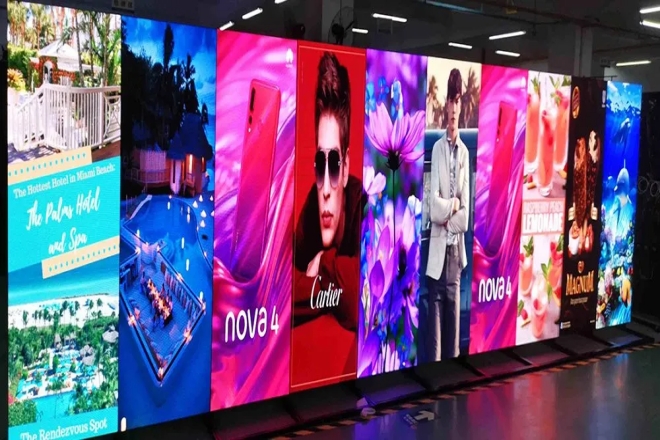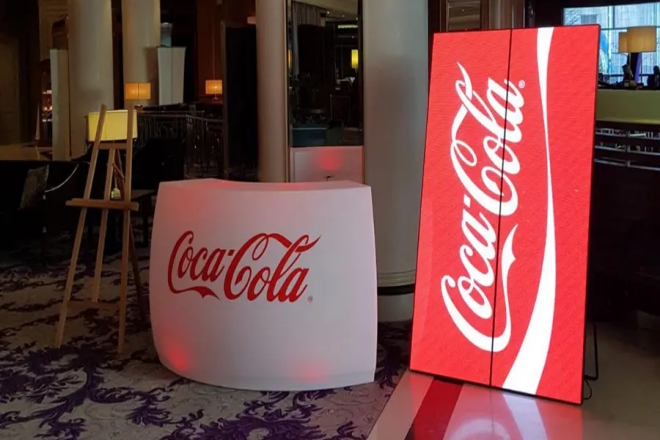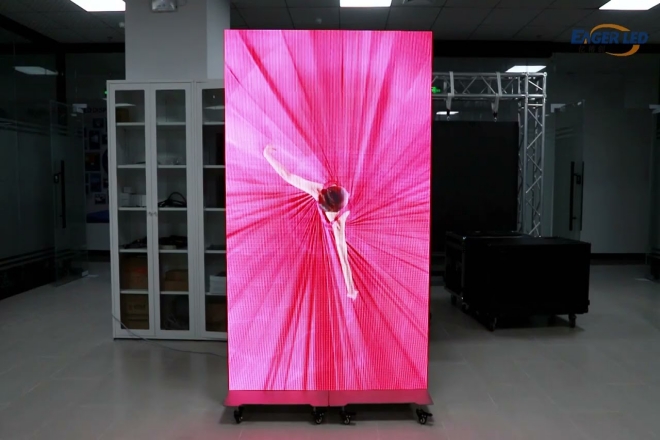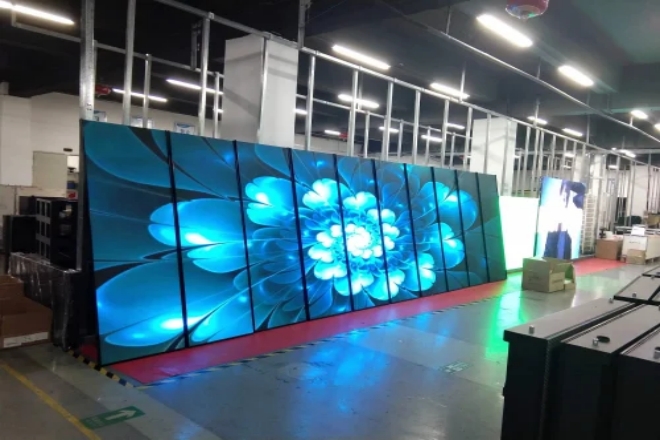مقدمة

LED technology innovates visual display, and the multi-screen splicing technology of poster LED displays perfectly combines the static beauty of traditional posters with the dynamic charm of LED.
Through seamless splicing, multiple screens form a shocking giant screen, making each screen the visual focus, bringing unprecedented visual impact and expressiveness to commercial publicity, event sites, and public information displays.
Now, let us experience this visual feast from the future and witness the infinite possibilities of multi-screen splicing poster LED display!
1. The poster LED principles and advantages of multi-screen splicing technology

1). Brief explanation of technical principles
Imagine that you have several small puzzles, each with its own small piece of image. When we put these small puzzles together precisely, they can be combined into a complete large picture, right? Multi-screen splicing technology is this principle, but it is implemented on electronic screens.
First, engineers will put together multiple poster LED screens like puzzles, making sure there are almost no gaps between them so that they look like a whole large screen. Then, through a special “image processor,” this processor is like a smart director.
It will ensure that the images on each screen can be perfectly connected without misalignment or overlap. Finally, the color of each screen will be fine-tuned to make them look more unified and harmonious.
2). Significant advantages are obvious at a glance
Bigger and more shocking: Compared with a single small screen, multiple screens can be spliced to form a super large display, just like the giant screen in a movie theater, which is unforgettable at first sight.
Clearer and more delicate: Because each screen has its own high resolution, after splicing, the clarity of the entire screen will be higher, the image will be more delicate, and it will look more comfortable.
Strong visual impact: Imagine a huge screen playing a wonderful picture; isn’t that a great shock? Multi-screen splicing technology can give you such an experience, allowing your eyes to enjoy a visual feast.
In general, multi-screen splicing technology is like turning multiple small screens into a big stage, allowing images and information to be presented in a more vivid and shocking way.
2. Exploration of new uses of multi-screen splicing poster LED displays

1). Visual magic of large-scale events
Imagine that you go to a concert or a football game, and the super large screen behind you is actually made up of many small screens.
These screens work together to put out super cool animations and colors, making the whole scene like magic. Such screens not only make the stage look cooler, but also make the audience more excited, feeling like they are part of the performance.
2). New ways to play commercial advertisements
في مراكز التسوق or pedestrian streets, have you noticed those super large advertising screens? They are also made of multi-screen splicing. These screens can play all kinds of interesting videos and interactive games to attract you to stop and take a look.
Merchants use this method to make advertisements more interesting and easier for people to remember their products.
3). Rapid transmission of public information
Sometimes, there will be emergency notices or important policies in the city to tell everyone. At this time, a multi-screen splicing poster LED display comes in handy. They can quickly display this information so that many people can see it.
For example, if there is a sudden rainstorm warning, these screens will immediately tell everyone to pay attention to safety.
4). Perfect combination of art and landscape
Multi-screen splicing technology can also be used in art and landscape. Artists can use it to create beautiful light and shadow works to make the city’s night more charming.
For example, on the lake surface of the park, through the poster LED display screen spliced by multiple screens, colorful light, and shadow can be projected, making the entire lake surface alive. Such works are not only pleasing to the eye but also enhance the cultural atmosphere of the city.
3. Poster LED Screen: Challenges and solutions

1) التحديات
1.1). Installation and debugging challenges
High splicing accuracy requirements: Multi-screen splicing requires the gap between each screen to be as small as possible to achieve a seamless splicing effect, which places high demands on the accuracy of installation and debugging.
Complex wiring: A large number of power lines and signal lines need to be carefully laid out to ensure stable signal transmission and uniform distribution of power, while avoiding safety hazards caused by chaotic wiring.
1.2). Content synchronization challenge
Synchronization performance issues: When multiple screens display content at the same time, it is necessary to ensure the synchronization of images and videos to avoid screen tearing, delays, etc.
Resolution adaptation: The resolutions of different screens may be different, and image processing technology is needed to achieve resolution adaptation to ensure the clarity and consistency of displayed content.
1.3). Maintenance and management challenges
Troubleshooting is difficult: Since the splicing screen is composed of multiple modules, when a fault occurs, it is necessary to quickly locate the specific module and repair it, which increases the difficulty of troubleshooting.
Inconvenient remote management: For splicing screens distributed in different locations, the traditional on-site management method is inefficient, and more efficient remote management and monitoring tools need to be developed.
2) الحل
2.1). Optimize splicing algorithm
Adopt advanced image processing algorithms to improve splicing accuracy and synchronization performance and ensure that multiple screens can maintain high consistency when displaying.
Develop intelligent splicing software, automatically adjust screen parameters through software, and reduce the difficulty and complexity of installation and debugging.
2.2). Strengthen remote monitoring
Develop a remote monitoring and fault diagnosis system to achieve real-time monitoring and fault warning of splicing screens through the network.
AI technology can be used for intelligent analysis to improve the accuracy and efficiency of troubleshooting and reduce the need for manual intervention.
2.3). Improve the after-sales service system.
Establish a professional after-sales service team to provide timely technical support and maintenance services to ensure that problems encountered by customers during use can be quickly resolved.
Provide regular training and technical guidance to customers to improve their ability to use and maintain spliced screens and extend the service life of the equipment.
خاتمة
Looking back on the rise and development of multi-screen splicing poster LED display screens, it is not difficult to find that this technology represents not only the power of scientific and technological progress but also the unremitting pursuit of human beings for a higher quality visual experience.
Through multi-screen splicing, we have broken the shackles of a single screen and achieved a qualitative leap in visual effects.
Whether it is a visual feast for large-scale events, a creative display of commercial advertisements, or a wide dissemination of public information, multi-screen splicing poster LED display screens have brought us unprecedented visual enjoyment with their unique charm.
وأخيرًا، إذا كنت تريد معرفة المزيد عن شاشات العرض LED، يرجى الحصول على اتصال معنا.
